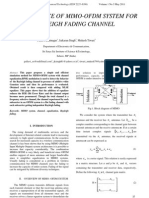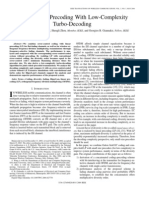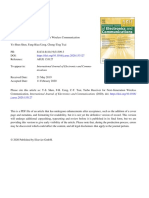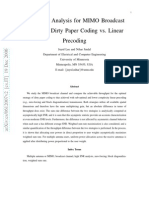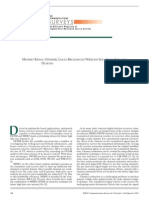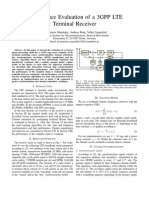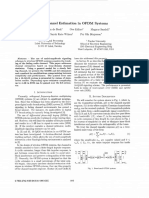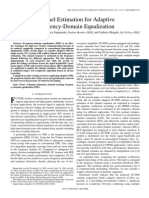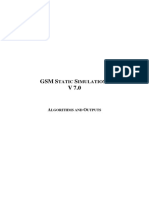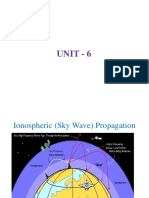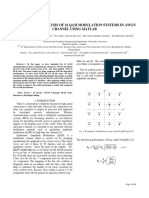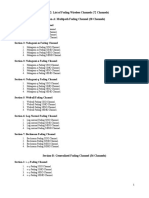The Performance Analysis of Non-Primitive Turbo Codes in MIMO System Over Flat Fading Channel
The Performance Analysis of Non-Primitive Turbo Codes in MIMO System Over Flat Fading Channel
Uploaded by
Tra LeCopyright:
Available Formats
The Performance Analysis of Non-Primitive Turbo Codes in MIMO System Over Flat Fading Channel
The Performance Analysis of Non-Primitive Turbo Codes in MIMO System Over Flat Fading Channel
Uploaded by
Tra LeOriginal Title
Copyright
Available Formats
Share this document
Did you find this document useful?
Is this content inappropriate?
Copyright:
Available Formats
The Performance Analysis of Non-Primitive Turbo Codes in MIMO System Over Flat Fading Channel
The Performance Analysis of Non-Primitive Turbo Codes in MIMO System Over Flat Fading Channel
Uploaded by
Tra LeCopyright:
Available Formats
The Performance Analysis of Non-primitive Turbo codes in MIMO System over Flat Fading Channel
Mingxin Tan .the Department of Information Technology, Central Chinese Normal University, Wuhan City, 430079, China tmingxin@yahoo.com.cn
Abstract
So far almost all the research work on turbo codes focus on primitive turbo code (PTC). In multiple input multiple output (MIMO) system this paper concentrates on the research of non-primitive turbo code (NOPTC) over flat fading channel. It shows that NOPTC outperforms PTC at any size SIR. Thus NOPTC promotes both capacity and reliability of the communications in MIMO system. This paper concludes as well there is no direct proportion between the state-number and the BER performance of turbo code.
2 Channel Model
Turbo and spacetime coding [3] are two of the most explored concepts in modern-day communication theory and wireless research (in this paper MIMO and spacetime coding are interchangeably used). In less than five years since the MIMO became widely known a great variety of techniques have evolved. In radio communications system antenna arrays are used to combat various types of channel impairments [4]. An antenna array with sufficient antenna spacing can provide spatial diversity to mitigate multi-path fading. Transmitting and reception diversity can be employed to combat the effect of delay spread and cochannel interference. Spacetime processing is a way to increase the possible capacity by exploiting the multi-path nature of fading wireless environments [5], while turbo coding/processing is a way to approach the Shannon limit on channel capacity. In this paper, Turbo code is considered as a channel code, and multiple antennas at both transmitter and receiver are used to overcome the interference over Rayleigh flat fading channel. Figure 1 shows the system block diagram. We consider a wireless communication system that employs n antennas both at transmitter and receiver. Normalise the total power transmitted from all transmitter antennas to 1. Let the signal transmitted from antenna i be represented by s i . Assume that all the antennas transmit simultaneously and have same transmission period. So equation (1) below:
1 Introduction
The research on turbo codes [1] has clearly shown its advantages over the conventional convolutional codes, and it is being widely used in wireless communications. Undoubtedly, the invention of Turbo codes is a milestone in the development of channel coding / decoding theory. Compared to other coding system, the improvement in performance obtained with turbo coding is so big that, for many applications, the gap between practical systems and Shannons theoretical limit essentially closed, a situation which was probably not predicted by anyone before the advent of turbo codes. However, So far almost all the research work[2] on turbo code only focus on PTC whose encoders/decoders consist of both primitive feedback polynomials and primitive generator polynomials, and when at a lower signal to interference (SIR) turbo code has poor bit error rate (BER) performance which influence the establishment and maintenance of the communications. Therefore, turbo code will be more widely applied in data communications once its Low SIR Performance is improved over severe wireless channel. This paper analyses in MIMO system NOPTCs performance over Rayleigh flat fading channel, and discusses their merits. Here NOPTCs consist of nonprimitive component codes, including both non-primitive feedback polynomials and non-primitive generator polynomials. This paper is organized into several sections. It is arranged as follows: Section 2 describes the system diagram concerning this papers research, Section 3 gives simulation results and analysis. Section 4 concludes the paper.
(1) S = [ s1 s 2 sj sn ] ' can be used to indicate the signal vector transmitted from all antennas (where X denotes the transpose conjugate of the vector or matrix X).The information bits are encoded by channel encoder and mapped to n signal streams corresponding to the n transmit antennas. Information bits are not encoded by n encoders corresponding to n transmit antennas but encoded by single block Turbo encoder and then mapped to each antenna to form transmission frames. The signal at each receive antenna is a noisy superposition of the transmitted signals corrupted by Rayleigh fading. The coefficient h ij is the path gain from
transmit antenna i to receive antenna j. We assume that the
1-4244-0517-3/06/$20.00 2006 IEEE
system works on Rayleigh fading channel, so hij are modeled as samples of zero mean complex Gaussian random
power N 0 / 2 replaces r.m.s. amplitude a. Then R is the signal set received from all antennas: R = [r1 r2 rj rn ] ' (5) Where
N = [n1
n2
nj
nn ] '
(6)
is the noise set on receive antenna array. Hence, the wireless link of the system can be describe as below: R = HS + N (7) Usually in coding/decoding theories and applications encoders/decoders consisting of primitive polynomials secure better BER/FER (frame error rate) performance than non-primitive polynomials, including linear block code (such as cyclic code), convolutional code and turbo code. Here several kinds of forward error correction (FEC) examples are provided to show PTCs wide application. For example, Cyclic Hamming codes [7, 4, 3] was earliest explored block code several decades ago, of which 7, 4, 3 stand for code length, information length and minimum Hamming distance, respectively, has the generator g ( x ) = x 3 + x 2 + 1 , It is seen g (x) is a primitive polynomial. So is the BCH code, such as BCH code [31, 11, 5], of which 31, 11, 5 denote code length, information length and maximum number of rectifiable error bits, respectively. Here the generator [31, 11, 5] is a primitive polynomial as well [6]. As to PTC, some probable reasons and analysis of poorer BER performance have been given in reference [7]. However, it does not provide practical measures to promote BER performance at lower SIR. It is known the BER performance of communications system is poorer when at a lower SIR [8], and in everyday life we often face severe wireless communications environment of lower and moderate SIR. In a real channel, the received signal consists of a combination of attenuated, reflected, refracted, and diffracted replicas of the transmitted signal. In addition to all these factors, the channel adds noise to the signal and can cause a shift in the carrier frequency if the transmitter/receiver is moving (Doppler effect). Understanding of these effects on the signal is of importance because the performance of a radio system depends on the radio channel characteristics. The block fading channel is a widely used model for dispersive wireless channels. In this model, the channel state remains xed over a block (or frame) of a given size, There are two ways to describe the block fading channel, first: to assume that the path gains do not change during a whole frame; or second: to assume that the path gains remain constant over a fixed transmission period T which is the number of the symbols transmitted from each antenna within the period. In this paper, the simulation program uses the second approach. It will be the same as the first when T is set to the length of the frame. The performance of BER vs SIR in SISO system is
Figure 1 System Block Diagram variables with variance 0.5 per dimension, as the equation below: (2) hij = a (0.7071 x + j 0.7071 y ) Where x, y are zero mean real Gaussian variables with variance 1, r.m.s. amplitude a is a constant: in the following parts of the report we assume that a is 1. The path gains along different path fade independently of one another. So we can use: hi1 hn1 h11 (3) H = h1 j hij hnj h1n hin hnn to annotate the path gains of the whole system. Extremely, for the fast Rayleigh fading channel, we assume that h changes from one symbol period to next, but remains same during each symbol period and for adjacent symbol periods hij h is uncorrelated. We here describe the block fading channel used in this paper: to assume that the path gains remain constant over a fixed transmission period T which is the number of the symbols transmitted from each antenna within the period. The signal received by antenna j at time t can be denoted by r j :
r j = hij s i + n j
i =1
(4)
n j are noise samples on receive antenna j, modelled as
independent samples of a zero mean complex Gaussian random variable with variance N 0 / 2 per dimension.Its mathematical expression is similar to hij except noise
1-4244-0517-3/06/$20.00 2006 IEEE
discussed in reference [2], and it is only limit to AWGN channel. This paper provides an applicable model, Rayleigh flat fading model.
10
10
-1
PTC-(23,35)-permuter=400 PTC-(37,21)-permuter=400 NOPTC-(33,25) -permuter=400
3 Performance Analysis
Simulation
Results
and
BER
10
-2
10
-3
In this paper, NOPTC is applied to MIMO system. Figure 3 compares the BER curves. As stated above, the simulation circumstance is block fading. In our simulation, (17,11) 8 and (11,17) 8 , (33,25)8 , (71,47 ) 8 and
10
-4
10
-5
10
-6
(55,63) 8 , (137,101) 8 and (167,101) 8 are investigated that
are 8-state 16-state 32-state and 64-state NOPTC, respectively.
10
-7
(13,15) 8 , (37,21) 8
4 Eb/N0(dB)
and
( 23,35) 8 ,
10
0
(b)
PTC-(73,45)-permuter=400 NOPTC-(71,47)-permuter=400 NOPTC-(55,63) -permuter=400
(73,45) 8 (177,103) 8 and (167,101) 8 are selected that are 8-state, 16-state, 32-state and 64-state PTC, respectively. Obviously PTC (13,15) 8 is what we often read in publications that is chosen as 3GPP standard [9] [10] for its excellent performance. The goal of performance comparison here is to promote turbo codes BER performance and ensure NOPTCs BER performance surpasses the existing application specification of international standard at least when working at lower and moderate SIR. The simulation conditions also include the following: interleaver depth 400 bits; code rate 1 / 3 ; the number of iteration 5; the number of transmit antenna and the number of receive antenna are both 4. Synthesize (a), (b), (c) and (d) of figure 3, we can see no matter at a lower, moderate, or higher SIR, PTC (13,15) 8 has the worst BER performance among the 8state turbo code; PTC (37,21) 8 the worst BER performance among the 16-state turbo code; PTC (73,45) 8 the worst
10
0
10
-1
10
-2
BER
10
-3
10
-4
10
-5
10
-6
4 Eb/N0(dB)
(c)
10
0
10
-1
PTC-(177,103)-permuter=400 NOPTC-(137,101)-permuter=400 NOPTC-(167,101)-permuter=400
10
-2
BER
10
-1
PTC-(13,15)-permuter=400 NOPTC-(11,17)-permuter=40 NOPTC-(17,11)-permuter=400
10
-3
10
-2
10
-4
BER
10
-3
10
-5
10
-6
10
-4
4 Eb/N0(dB)
10
-5
10
-6
3 4 Eb/N0(dB)
(a)
(d) Figure 3 BER comparison betweenNOPTCand PTC over flat fading channel (a) BER performance of 8-state turbo code; (b) BER performance of 16-state turbo code; (c) BER performance of 32-state turbo code; (d) BER performance of 64-state turbo code.
1-4244-0517-3/06/$20.00 2006 IEEE
BER performance among the 32-state turbo code; and PTC (177,103) 8 the worst BER performance among the 64-state turbo code. In summary, among all the investigated PTC and NOPTC, NOPTC secures better BER performance when compared under the equal both state-number and other simulation conditions. Among the investigated 64-state NOPTCs, (167,101) 8 has best performance, and the transfer function for (167,101) 8 is:
differences between NOPTC and PTC over Rayleigh flat fading channel. As a result, For the explored codes, NOPTC outperforms PTC at lower, moderate and high SIR. Better performance will be expected in the future.
References
[1] C. Berrou and A. Giavieux. Near optimum error correcting coding and decoding: Turbo-codes. IEEE Trans. Commun.,
vol. 44, no. 10. Oct., 1996:1261-1271P (8)
[2] Mingxin Tan, Alister G. Burr, Non-primitive Turbo codes, Proceedings of First International Symposium on Broadband Communications, Harrogate, England, 12-15, Dec., 2004, page 61 [3] Branka Vucetic, Jinhong Yuan, Space-Time Coding, Wiley Editorial Office 2003 [4] Da-shan Shiu, Wireless Communication Using Dual Antenna Arrays, Kluwer Academic Publishers, 2000 [5] Sirikiat Lek Ariyavisitakul, Turbo Space Time Processing to Improve Wireless Channel Capacity, IEEE Transactions on communications, vol. 48, no. 8, August 2000 [6] Shu Lin. An Introduction to Error Correcting Codes. PrenticeHall, Englewood Cliffs, NJ, 1970 [7] L. C. Perez, J. Seghers, and D. J. Costello. A distance spectrum interpretation of turbo codes. IEEE Trans. Inform. Theory, vol.42., Nov, 1996: 1698-1709P [8] Oscar Y. Takeshita, Oliver M. Collins, Peter C. Massey, and Daniel J. Costello, Jr. On the Frame Error Rate of Turbo Codes, IEEE Transctions on Communications, Vol. 49, No. 4, April 2001. [9]Third Generation Partnership Project Multiplexing and channel coding, 3G TS 25.222 V3.2.0, [10]Third Generation Partnership Project Multiplexing and channel coding, 3G TS 25.212 (DRAFT) [11]Third Generation Partnership Project Quality of Service concept and architect- ture (Release 6), 3GPP TS 23.107 V6.2.0 (2004-12) [12] Third Generation Partnership Project QoS Concept and
g ( D) G ( D) = 1, 1 g 0 ( D)
Where
g 0 ( D) = 1 + D + D 2 + D 4 + D 5 + D 6
(9)
(10) From the simulation results of figure 3, comparing with other 8-state, 16-state and 32-state it is seen as well that 64state turbo code doesnt have best BER performance when at lower and moderate SIR , nor at higher SIR. It is NOPTC (17,11) 8 has best BER performance at any SIR. Obviously, the assertion the more state numbers turbo code has, the better performance turbo code achieves doesnt meet in SISO system, neither in MIMO system here. In a word, there is no direct proportion between the state-number and the BER performance of turbo code. Here we analyze the structure of feedback polynomial. From the simulation results, it is seen those feedback polynomials that contain more component 1 (not component 0) in the feedback polynomials have better BER performance when working at the equal SIR and other simulation conditions. The number of 1 doesnt include both the Least Significant bit (LSM) and the Most Significant bit (MSB). In convolutional code and turbo code theory, LSB and MSB corresponding to a polynomial item stand for output and input, respectively. In feedback polynomial structure, apart from LSB and MSB, other 1s mean the information feeds back to the input, 0s mean the information doesnt feed back to the input. Therefore, in feedback polynomial structure, more 1 denotes more external information feeds back to the input, which will contribute to recovering the original transmission information reliably. In practical application standards, for the 3G speech codec and the MPEG-4 video codec [11] [12], specification of PTC can implement both visible artefacts and speech communications. According to the results above, NOPTC will run better in both visible artefacts and speech communications. 4 Conclusions This paper investigates the BER performance
g1 ( D ) = 1 + D 6
Architecture (Release 1999), 3GPP TS 23.107 V6.2.0 (2004-12)
1-4244-0517-3/06/$20.00 2006 IEEE
You might also like
- 57789-Điều văn bản-162562-1-10-20210525Document16 pages57789-Điều văn bản-162562-1-10-20210525ductaingo0123No ratings yet
- Performance of Mimo-Ofdm System For Rayleigh Fading Channel: Pallavi Bhatnagar, Jaikaran Singh, Mukesh TiwariDocument4 pagesPerformance of Mimo-Ofdm System For Rayleigh Fading Channel: Pallavi Bhatnagar, Jaikaran Singh, Mukesh TiwariNung NingNo ratings yet
- Performance of Mimo-Ofdm System For Rayleigh Fading Channel: Pallavi Bhatnagar, Jaikaran Singh, Mukesh TiwariDocument4 pagesPerformance of Mimo-Ofdm System For Rayleigh Fading Channel: Pallavi Bhatnagar, Jaikaran Singh, Mukesh TiwariNebiye SolomonNo ratings yet
- The LabVIEW Simulation of Space-Time Coding Technique in The MIMO-OfDM SystemDocument6 pagesThe LabVIEW Simulation of Space-Time Coding Technique in The MIMO-OfDM Systemivy_publisherNo ratings yet
- Adaptive Coded Modulation With Receive Antenna Diversity and Imperfect Channel Knowledge at Receiver and TransmitterDocument7 pagesAdaptive Coded Modulation With Receive Antenna Diversity and Imperfect Channel Knowledge at Receiver and TransmitterMatthew Luis Llano LoveraNo ratings yet
- Joint Coding-Precoding With Low-Complexity Turbo-DecodingDocument11 pagesJoint Coding-Precoding With Low-Complexity Turbo-DecodingSumala G LakshmiNo ratings yet
- System Model of TH-UWB Using LDPC Code ImplementationDocument7 pagesSystem Model of TH-UWB Using LDPC Code ImplementationJournal of TelecommunicationsNo ratings yet
- Turbo Codes in MIMO System: 0-7803-9335-X/05/$20.00 ©2005 IEEE 281Document3 pagesTurbo Codes in MIMO System: 0-7803-9335-X/05/$20.00 ©2005 IEEE 281Tra LeNo ratings yet
- Performance Analysis of MIMO-OFDM Systems On Nakagami-M Fading ChannelsDocument5 pagesPerformance Analysis of MIMO-OFDM Systems On Nakagami-M Fading ChannelsmnoppNo ratings yet
- BER of OFDM System Using Concatenated Forward Error Correcting Codes (FEC) Over Nakagami-M Fading ChannelDocument5 pagesBER of OFDM System Using Concatenated Forward Error Correcting Codes (FEC) Over Nakagami-M Fading Channelseventhsensegroup100% (1)
- Journal Pre-Proofs: International Journal of Electronics and Commu-NicationsDocument23 pagesJournal Pre-Proofs: International Journal of Electronics and Commu-NicationsSebastian LopezNo ratings yet
- High SNR Analysis For MIMO Broadcast Channels: Dirty Paper Coding vs. Linear PrecodingDocument33 pagesHigh SNR Analysis For MIMO Broadcast Channels: Dirty Paper Coding vs. Linear Precodingkumaar1943No ratings yet
- A Tutorial On SISO and MIMO Channel CapacitiesDocument4 pagesA Tutorial On SISO and MIMO Channel Capacitiesmashkoor86No ratings yet
- Maximum Ratio Transmission: Titus K. Y. LoDocument4 pagesMaximum Ratio Transmission: Titus K. Y. LoButtordNo ratings yet
- Experiment No.1: 1. AIM: 2. EquipmentDocument7 pagesExperiment No.1: 1. AIM: 2. EquipmentNilesh RathoreNo ratings yet
- Performance Analysis of A Trellis Coded Beamforming Scheme For MIMO Fading ChannelsDocument4 pagesPerformance Analysis of A Trellis Coded Beamforming Scheme For MIMO Fading ChannelsMihai ManeaNo ratings yet
- Channel Estimation LmmseDocument31 pagesChannel Estimation LmmseNabeel JarralNo ratings yet
- Spectral Content of NRZ Test PatternsDocument5 pagesSpectral Content of NRZ Test PatternsRohan RajagopalNo ratings yet
- An Efficient LMMSE Estimator For MIMOOFDM Systems Over Flat Fading ChannelDocument4 pagesAn Efficient LMMSE Estimator For MIMOOFDM Systems Over Flat Fading ChannelseventhsensegroupNo ratings yet
- A Broadband Cmos Multiplier-Based Correlator For Ir-Uwb Transceiver SocDocument4 pagesA Broadband Cmos Multiplier-Based Correlator For Ir-Uwb Transceiver SocmiracuNo ratings yet
- Novel WeigtedDocument5 pagesNovel WeigtedLiju TrNo ratings yet
- Performance Analysis of OFDM For 4G Wireless Systems Under Various Fading ChannelsDocument4 pagesPerformance Analysis of OFDM For 4G Wireless Systems Under Various Fading ChannelsJuan Dela CruzNo ratings yet
- Alamouti 2x3Document4 pagesAlamouti 2x3Bharghava Sasanka DesuNo ratings yet
- DSTC Layering Protocols in Wireless Relay NetworksDocument14 pagesDSTC Layering Protocols in Wireless Relay NetworksepannirselvamNo ratings yet
- Sukh 04560087 SukhDocument7 pagesSukh 04560087 SukhmalhiavtarsinghNo ratings yet
- Performance Evaluation of A 3GPP LTE Terminal Receiver: Konstantinos Manolakis, Andreas Ibing, Volker JungnickelDocument5 pagesPerformance Evaluation of A 3GPP LTE Terminal Receiver: Konstantinos Manolakis, Andreas Ibing, Volker Jungnickelhanochk12No ratings yet
- Channel Estimation ITC CSCC2011 ChimuraDocument4 pagesChannel Estimation ITC CSCC2011 Chimuraحاتم الشرڭيNo ratings yet
- On Channel Estimation in OFDM SystemsDocument5 pagesOn Channel Estimation in OFDM SystemsSoumitra BhowmickNo ratings yet
- Comparative Evaluation of Bit Error Rate For Different Ofdm Subcarriers in Rayleigh ChannelDocument8 pagesComparative Evaluation of Bit Error Rate For Different Ofdm Subcarriers in Rayleigh ChannelLawrence AveryNo ratings yet
- Optimum Power Allocation For Fading Relay Channels: Muhammad Mehboob Fareed and Murat UysalDocument5 pagesOptimum Power Allocation For Fading Relay Channels: Muhammad Mehboob Fareed and Murat UysalballmerNo ratings yet
- Analysis Simulation of Ds-Cdma Mobile System in Non-Linear, Frequency Selective Slow ChannelDocument5 pagesAnalysis Simulation of Ds-Cdma Mobile System in Non-Linear, Frequency Selective Slow ChannelAnonymous JPbUTto8tqNo ratings yet
- Multiple InterferenceDocument4 pagesMultiple InterferenceVikas AgrawalNo ratings yet
- Performance Analysis of Phase Noise Impaired Ofdm Systeminamultipath Fading ChannelDocument6 pagesPerformance Analysis of Phase Noise Impaired Ofdm Systeminamultipath Fading Channeljagadeesh jagadeNo ratings yet
- Ofdm Cognitive Radio ThesisDocument4 pagesOfdm Cognitive Radio Thesisjmvnqiikd100% (2)
- MIMO in LTE Operation and Measurement - Excerpts On LTE Test: Application NoteDocument25 pagesMIMO in LTE Operation and Measurement - Excerpts On LTE Test: Application Noteankroto1No ratings yet
- A Conceptual Study of OFDM-based Multiple Access SchemesDocument7 pagesA Conceptual Study of OFDM-based Multiple Access SchemeswoodksdNo ratings yet
- A Systematic Approach To Peak-to-Average Power Ratio in OFDMDocument11 pagesA Systematic Approach To Peak-to-Average Power Ratio in OFDMWaled Fouad GaberNo ratings yet
- Background Optical Noises Circumvention in LED Optical Wireless Systems Using OFDMDocument10 pagesBackground Optical Noises Circumvention in LED Optical Wireless Systems Using OFDMtariq76No ratings yet
- A Novel Channel Estimation Algorithm For 3GPP LTE Downlink System Using Joint Time-Frequency Two-Dimensional Iterative Wiener FilterDocument4 pagesA Novel Channel Estimation Algorithm For 3GPP LTE Downlink System Using Joint Time-Frequency Two-Dimensional Iterative Wiener FilterSinshaw BekeleNo ratings yet
- A 4x4 MIMO-OFDM System With MRC in A Rayleigh Multipath Channel For WLANDocument4 pagesA 4x4 MIMO-OFDM System With MRC in A Rayleigh Multipath Channel For WLANzizo1921No ratings yet
- A Ce Lte Almmse ImplDocument5 pagesA Ce Lte Almmse ImplnogoodskamNo ratings yet
- On The Performance of Cooperative Amplify-and-Forward Relay NetworksDocument8 pagesOn The Performance of Cooperative Amplify-and-Forward Relay NetworksballmerNo ratings yet
- Ieee 802.11N: On Performance of Channel Estimation Schemes Over Ofdm Mimo Spatially-Correlated Frequency Selective Fading TGN ChannelsDocument5 pagesIeee 802.11N: On Performance of Channel Estimation Schemes Over Ofdm Mimo Spatially-Correlated Frequency Selective Fading TGN Channelszizo1921No ratings yet
- Publications SmartAntennasDocument8 pagesPublications SmartAntennasCatherine PetersNo ratings yet
- Channel Estimation For Adaptive Frequency-Domain EqualizationDocument11 pagesChannel Estimation For Adaptive Frequency-Domain Equalizationअमरेश झाNo ratings yet
- Frequency Domain Techniques For Void Spectrum Detection in Cognitive Radio NetworkDocument20 pagesFrequency Domain Techniques For Void Spectrum Detection in Cognitive Radio NetworkPRANAV KUMAR 17BEC0473No ratings yet
- Error Probability of Different Modulation Schemes For OFDM Based WLAN Standard IEEE 802.11aDocument6 pagesError Probability of Different Modulation Schemes For OFDM Based WLAN Standard IEEE 802.11aaboashoorNo ratings yet
- Training Sequence Assisted Channel Estimation For Mimo Ofdm: Sumei Sun, Ingo Wiemer, C. K. Ho, and T. T. TjhungDocument6 pagesTraining Sequence Assisted Channel Estimation For Mimo Ofdm: Sumei Sun, Ingo Wiemer, C. K. Ho, and T. T. TjhungSandeep SunkariNo ratings yet
- A Study On Pseudo CRS Signal Jamming Attacks in LTE NetworkDocument4 pagesA Study On Pseudo CRS Signal Jamming Attacks in LTE NetworkÖzgür ErtuğNo ratings yet
- (1967) Digital Pulse Compression Radar ReceiverDocument9 pages(1967) Digital Pulse Compression Radar ReceiverAlex YangNo ratings yet
- An Experimental OFDM-Modem For The CENELEC B-BandDocument8 pagesAn Experimental OFDM-Modem For The CENELEC B-Bandu235861No ratings yet
- Power Allocation in RelayingDocument4 pagesPower Allocation in RelayingArunmozhi SinouvassaneNo ratings yet
- Introduction To MIMO SystemsDocument8 pagesIntroduction To MIMO SystemsnataliiadesiiNo ratings yet
- Performance Evaluation of Ds-Cdma System Using MatlabDocument13 pagesPerformance Evaluation of Ds-Cdma System Using MatlabMuhammad FirdausNo ratings yet
- Implementation of OFDM Transmitter and Receiver Using FPGA: Nasreen Mev, Brig. R.M. KhaireDocument4 pagesImplementation of OFDM Transmitter and Receiver Using FPGA: Nasreen Mev, Brig. R.M. Khaireankita6298No ratings yet
- Convolutional Coded On-Off Keying Free-Space Optical Links Over Fading ChannelsDocument6 pagesConvolutional Coded On-Off Keying Free-Space Optical Links Over Fading ChannelsseventhsensegroupNo ratings yet
- Carrier Frequency Synchronization in The Downlink of 3Gpp LteDocument6 pagesCarrier Frequency Synchronization in The Downlink of 3Gpp LteAshok KumarNo ratings yet
- Channel Estimation EJSR 70-1-04Document8 pagesChannel Estimation EJSR 70-1-04حاتم الشرڭيNo ratings yet
- Mimo Thesis With Matlab CodeDocument7 pagesMimo Thesis With Matlab Codecatherinefrostickvirginiabeach100% (2)
- Calicut University - Viii Semester Ece Btech 2004 SyllabusDocument19 pagesCalicut University - Viii Semester Ece Btech 2004 SyllabusRakesh GopalanNo ratings yet
- TM355: Communication Technologies: Block 1Document42 pagesTM355: Communication Technologies: Block 1HusseinJdeedNo ratings yet
- GSM Static SimulationsDocument24 pagesGSM Static Simulationstest321yNo ratings yet
- Syllabus MECCE Syllabus FinalDocument14 pagesSyllabus MECCE Syllabus FinalPhilip G GeojiNo ratings yet
- Satcom Lab ManualDocument56 pagesSatcom Lab ManualBhagubhai MafatlalNo ratings yet
- 04-WCDMA RNP LinkBudget - 20051214Document63 pages04-WCDMA RNP LinkBudget - 20051214Hidayat EncuhNo ratings yet
- Syllabus 5TH SemDocument7 pagesSyllabus 5TH SemarivasanthNo ratings yet
- Awp U-6Document48 pagesAwp U-6Gajula Venkat SaiNo ratings yet
- Design of STBC-WIMAX System by Using DWT With Four Transmit Antennas in Fading ChannelDocument10 pagesDesign of STBC-WIMAX System by Using DWT With Four Transmit Antennas in Fading ChannelJournal of TelecommunicationsNo ratings yet
- Experiment: 6 ObjectDocument5 pagesExperiment: 6 ObjectShivratan GuptaNo ratings yet
- Performance of Fso Links Using Various Modulation Techniques and Cloud EffectDocument6 pagesPerformance of Fso Links Using Various Modulation Techniques and Cloud EffectJabeena AfthabNo ratings yet
- Performance Analysis of 16 Qam Modulation Systems in Awgn Channel Using MatlabDocument6 pagesPerformance Analysis of 16 Qam Modulation Systems in Awgn Channel Using MatlabAnonymous elrSyA30No ratings yet
- Cu7201 Wireless Communication Networks L T P CDocument3 pagesCu7201 Wireless Communication Networks L T P CWesley Moses SamdossNo ratings yet
- WCDMA RAN OverviewDocument44 pagesWCDMA RAN OverviewmegzgreatNo ratings yet
- MCQ-WCN 2 SDocument32 pagesMCQ-WCN 2 SM.Ganesh Kumar mahendrakar100% (1)
- GSM-To-UMTS Training Series 02 - WCDMA Radio Network Coverage Planning - V1.0Document86 pagesGSM-To-UMTS Training Series 02 - WCDMA Radio Network Coverage Planning - V1.0AliKaiserNo ratings yet
- Dokumen - Tips - Link Budget Lte UplinkDocument3 pagesDokumen - Tips - Link Budget Lte UplinkMohamed EmadNo ratings yet
- 3G SIB4 ActivationDocument11 pages3G SIB4 ActivationSahinba SahinNo ratings yet
- Pinoy Bix Radio Wave Propagation Answer KeyDocument14 pagesPinoy Bix Radio Wave Propagation Answer KeykathrineNo ratings yet
- 19.CDMA Link Budget (V0.1)Document31 pages19.CDMA Link Budget (V0.1)Hadi AgustanaNo ratings yet
- Manual on-Cellular-Mobile-CommunicationDocument42 pagesManual on-Cellular-Mobile-CommunicationAnonymous 1XnVQmNo ratings yet
- ENB20-DMR Repeater PDFDocument20 pagesENB20-DMR Repeater PDFMicheal Kyaw ZinNo ratings yet
- Introduction To WCDMA Fundamentals NokiaDocument106 pagesIntroduction To WCDMA Fundamentals NokiaSadasivan Ep100% (2)
- FFFF R HDB 59 2014 PDF eDocument66 pagesFFFF R HDB 59 2014 PDF eAnonymous tLqlhEDNo ratings yet
- Lecture-2: List of Fading Wireless Channels (72 Channels) Section-A: Multipath Fading Channel (28 Channels)Document7 pagesLecture-2: List of Fading Wireless Channels (72 Channels) Section-A: Multipath Fading Channel (28 Channels)Sarwar Hosen SimonNo ratings yet
- Diversity Techniques: Vasileios PapoutsisDocument41 pagesDiversity Techniques: Vasileios PapoutsishusseinelatarNo ratings yet
- Transmission MCQ Pinoy Bix 400Document23 pagesTransmission MCQ Pinoy Bix 400kathrineNo ratings yet
- Chapter 3: Physical-Layer Transmission Techniques: Section 3.2: Performance Analysis Over Fading ChannelsDocument22 pagesChapter 3: Physical-Layer Transmission Techniques: Section 3.2: Performance Analysis Over Fading ChannelsReno TkNo ratings yet
- partIV p2 v1Document63 pagespartIV p2 v1Rk ManjunathNo ratings yet

